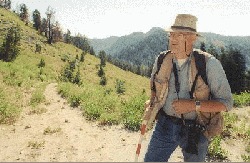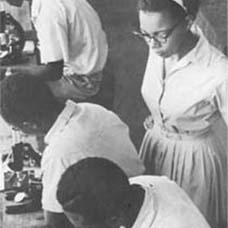
Chile RPCV Charlie Johnson, who turns 61 next week, was the first plant ecologist to work exclusively on the Wallowa-Whitman, Umatilla and Malheur national forests
Of the Wallowas and a life's work
Published: November 15, 2004
Charlie Johnson stands in the Elkhorn Mountains west of Baker City in this 1998 photo. Johnson, the Forest Service's first plant ecologist in Northeastern Oregon, will retire at the end of 2004, concluding a 27-year career in that job.
S. John Collins/file photograph
By JAYSON JACOBY
Of the Baker City Herald
Charlie Johnson blames pretty much everything, at least after 1960, on the bookmobile and the Supreme Court justice.
The justice didn't drive the bookmobile, but Johnson doesn't see how that absolves the man.
These two elements, which seem about as similar as a kitten and an asteroid, determined much of the course of Johnson's life from that day on.
They, more than any other factor, brought Johnson to Baker City.
And now, 25 years after he settled here, and 44 years after the bookmobile and the justice arrived, Johnson needs to flip only one page of his calendar to see the end.
When 2004 concludes, so too will his career as a plant ecologist for the U.S. Forest Service.
Johnson, who turns 61 next week, was the first plant ecologist to work exclusively on the Wallowa-Whitman, Umatilla and Malheur national forests.
He started in 1977.
During the ensuing quarter century Johnson hiked thousands of miles through canyons and forests and mountains, snapped thousands of photographs and wrote thousands of words about the trees and the grasses and the wildflowers he saw and touched and smelled.
And yet, on the cusp of retirement, the tale that he must tell the one he admits remains his favorite has as its main characters not pine trees and sagebrush, but that bookmobile and that Supreme Court justice.
It happened in a tiny town in the farmlands of southern New Jersey called Mullica Hill.
The population of Mullica Hill in 1960 was about 700 too few to warrant a library but enough to support a Grange Hall, which is where the bookmobile parked once a month.
The teen-aged Johnson greeted the bookmobile with the enthusiasm of an eight-year-old who sees the ice cream man.
"I've always been a reader, and I knew I wanted to be a botanist, so I would go to the bookmobile and pick out a book about plants," he said.
But one day in 1960, when Johnson was a high school student, he slid from the traveling library's shelves a book that wasn't about plants at all.
Its title is "Of Men and Mountains," its author William O. Douglas, who served on the Supreme Court from 1939 to 1975.
"To this day I can't tell you why I picked up that book," Johnson said.
But he can tell you why he couldn't put it down.
Douglas wrote about a place that captured Johnson's imagination as no other place ever had.
And the mountains that Douglas' prose so eloquently portrayed are not works of fiction, but real peaks of white granite and limestone that scrape the sky.
They are called the Wallowas.
And in 1960 Johnson did not know they existed.
"I had to look at a map to know where the Wallowa Mountains are," he said. "And I probably pronounced the word wrong."
Johnson pauses, then grins a slightly guilty grin.
"Actually, I know I pronounced it wrong."
He learned to pronounce it right.
After graduating from high school in 1962, Johnson traveled across an entire continent well, most of one to study forestry at the University of Idaho in Moscow.
You can't quite see the Wallowas from there. But almost.
And then Johnson met someone who lived in the very shadow of those mountains.
Joe Hopkins graduated from high school in the same three-student class with Johnson's grandmother, Alice Johnson.
In the spring of 1963 Hopkins, who had moved to Enterprise, invited Charlie Johnson for a visit.
Not long after, Johnson cadged a ride from a college buddy. They drove south from Moscow, negotiated the stomach-churning curves of the Rattlesnake Grade and, at the top of the grade high above the Grande Ronde River, Johnson glimpsed for the first time the mountains he already loved.
"I was big into hiking and climbing, so I made a lot of trips" to the Wallowas over the next few years, Johnson said.
In 1965 he wrote a letter to the Forest Service ranger in Joseph, asking about a job. Johnson doesn't actually say so, but he conveys the impression that he would have begged the ranger had that been required.
It wasn't.
During the summer of 1965 Johnson worked as an engineering aide, laying out a logging road.
When he wasn't working he was scrambling up steep slopes in the Wallowas.
"I climbed 15 of the highest peaks," he said. "My goal was to hit the top 20, but I'm still a couple short."
During the following winter Johnson wrote a second letter to the ranger. This time, though, he asked for a specific job. He yearned to work in the heart of the Wallowas the Eagle Cap Wilderness, designated by Congress less than two years earlier as part of the original 1964 Wilderness Bill.
Johnson's persistence paid off again. In the summer of 1966 his office was a tent pitched in the Eagle Cap's Lakes Basin, and the way he figured it no executive with a desk high in a skyscraper ever enjoyed a more spectacular view.
When Johnson sat down to lunch he saw not bustling streets littered with scurrying yellow cabs, but dirt paths where mule deer and mountain goats gamboled with considerably more grace than a Checker can manage. His skyline was made not of concrete and steel and glass, but of snaggle-toothed peaks whose pinnacles reflected in the ice-blue water of the lakes.
"I went to my office for 10 days and then reluctantly had to go back to town for six days off," Johnson said. "That summer solidified it for me."
He definitely wanted to study plants.
And now he knew where.
But Johnson still had a few detours to follow before his travels ended in Baker City.
After earning a bachelor's degree in forest resources management from Idaho in 1967, Johnson joined the Peace Corps and spent three years in Chile. There he studied plants in the Andes Mountains.
And more important for Johnson, he met his wife, Angelica.
The couple returned to Idaho, where Johnson received a master's degree in forest ecology in 1972.
They moved to Prairie City that year, where Johnson again worked for the Forest Service, first fixing trails in the Strawberry Mountains, then for three years in forest management.
But ecologist remained his dream job.
Around 1975 he met Fred Hall, an ecologist who worked at the Forest Service's regional office. Two years later Hall hired Johnson as the first "area" ecologist for Northeastern Oregon, his area comprising the Wallowa-Whitman, Umatilla and Malheur national forests.
For the first few years he mixed work with school. In 1982 he received his doctorate, in plant ecology, from Oregon State University.
And it was about that time that Johnson roughed out the work schedule he refers to it as "the regimen" that he would follow for the rest of his career.
From May through September Johnson avoided the office as though it were infected with a contagious and potentially lethal disease.
He worked instead in the woods, tramping around the botanically rich region that served as his laboratory. Like the deer and the elk, he migrated with the seasons, starting in spring in the mild canyons and then chasing the snowline as it climbed into the mountains through the summer.
His goal was an ambitious one, and worthy of a long career: to know each of the hundreds of species of flora that grow here, to know why they grow in one place but not in another, to know how they react to disturbances such as the logger's chain saw and the lightning-sparked wildfire.
This was a task for a scientist.
No longer was Johnson a carefree youth who surmounted summits just to revel in the three-state view.
During his career he set up about 5,000 "plots" pieces of ground covering about a tenth of an acre. He spent hours scrutinizing each plot, describing each one in detail and noting every plant he found there. Every year he filled four notebooks with words. He could have filled more but his meticulous nature controls even his penmanship "I write small," he said.
And like a coroner conducting an autopsy, Johnson also relied on a microcassette recorder, narrating the works of nature as he walked across each plot.
"I called it my field secretary, or my no-talk-back secretary," he said.
During his "office season," which ran from October through April, Johnson sequestered himself behind his desk in Baker City, transcribing his spoken words onto paper, arranging his hundreds of black-and-white prints and color slides, and writing the several field guides the Forest Service published.
He enjoyed the office work.
But he loved that field regimen.
"I'm totally a field person," Johnson said.
Many Forest Service workers, as they progress in their career, earn promotions to jobs that bind them to a desk.
Johnson reached that fork in his career path several times. Always he shunned the sedentary route.
"I'm the exception to that rule," Johnson said.
He said some co-workers thought he should have spent more time in the office, less time in the mountains.
"I've had critics," Johnson said.
But he always figured he could learn more about a plant by running his finger along its petals rather than shuffling through some other scientist's book.
He admits, though, that his devotion to hands-on work forced him to forego time with his family.
During the five-month field season, Angelica and the couple's daughters, Audrey and Melica, wouldn't see Johnson for at least five days in a row, and often eight to 10.
For several years Johnson tried to schedule his summer field work so he could stay in a Forest Service guard station, where his wife and daughters could stay with him.
He said his family handled his frequent absences with an admirable amount of patience.
"One thing I will say Saturday night (during his retirement party) to my family is thank you for sticking with me,' " Johnson said.
Johnson's legacy will survive far longer than he will.
Decades after he is gone, people will still read his books, and maybe giggle with delight when they discover a delicate flower sprouting from a crack in a chunk of granite and realize, after perusing the proper page, that they know its name.
Johnson's reams of unpublished work will endure, as well.
He designed every one of those 5,000 plots with permanence in mind. He marked the exact location on paper, and hammered metal stakes into the ground so there is no doubt.
Because he did, future generations of ecologists can walk where Johnson walked, and study the same patch of ground where Johnson once hunkered, notebook in one hand, recorder in the other.
Perhaps they will find different plants than he did.
Even during Johnson's career, which was long in human terms but merely a brief interlude in nature's timeline, his beloved Wallowas have changed in drastic ways he could not have predicted during that summer of 1966 in the Lakes Basin.
"The most incredible change, I think, is the discovery of the Wallowa Mountains by people far and wide," he said.
When Johnson visits the Lakes Basin these days, he watches, amazed, as dusk falls and lanterns twinkle across the basin, "like fireflies," as he puts it.
"Today, the Lakes Basin is not a place to go for solitude," Johnson said.
He hiked the Hurricane Creek trail this Labor Day weekend and met at least 30 people. Back in the '60s, he said, he might not have passed even one hiker on that trail.
It will be someone else's job to learn whether the Wallowas' growing popularity will affect their ecology.
Maybe Johnson's successor, David Swanson, will write the next book.
"I'm absolutely thrilled that he's the individual" who will carry on the work, Johnson said.
He's also thrilled that his career as a Forest Service ecologist, which Johnson describes, with a laugh, as a "hobby job" will end where it began.
He and Angelica, who also works for the Forest Service and will retire in three years, plan to stay in Baker City.
"If I had to do it all over again I would do it pretty much the same," Johnson said. "I look back on it and I'm glad it happened the way it did. Baker City is a great place to live."







